According to the Oxford English Dictionary, the definition of a wholesaler is ‘the selling of goods in large quantities to be retailed by others’. The reality is not so cut and dried. At least, not in grocery wholesale in 2014.
This year sees the publication of The Grocer’s 10th Big 30 Wholesaler ranking. The list has become a useful snapshot of the state of the UK’s biggest grocery wholesalers, but as time passes, the definition of a wholesaler has become increasingly blurred as companies push further into retail, focus on pure distribution and logistics, or become suppliers and brand owners in their own right.
See the full Big 30 table here.
So what does it mean to be a wholesaler in 2014? How has wholesale changed? And why?
In The Grocer’s first Big 30, in 2005, it was easy to define a wholesaler. That list pigeonholed wholesalers as cash & carry, delivered or foodservice operators.
But the Big 30 2014 is harder to categorise. Take DCS Europe (25) for example. It’s been on the rankings since the beginning, but now insists it is no longer a wholesaler - instead describing itself on its website as a ‘sales and distribution’ company.
“We are a supplier like SHS Sales & Marketing,” says CEO Denys Shortt. “We supply wholesalers and retail groups such as Halfords, B&Q, etc.”
DCS has evolved considerably since it appeared in the first Big 30. It is now an official UK sales and distribution company for Procter & Gamble, Unilever, Colgate, PZ Cussons, SC Johnson, Osram and L’Oréal and also owns the Enliven brand, which is sold in 70 countries worldwide. On the first Big 30, its turnover was listed as £80m - this year it is £148.4m and claims it is on track to top sales of £210m in 2014.
It’s not the only anomaly on the list. With newspaper and magazine sales in decline, Smiths News (6) and Menzies Distribution (9) have diversified to maintain sales and profits. Smiths now has an educational supplies arm, a media division and a books business. And last October, Menzies launched Menzies Logistics Solutions - to make the most of its fleet.
“We are building on our strengths to provide new services and ensure the long-term success of our business,” says outgoing Menzies Distribution MD David McIntosh. “Last year, we secured a three-year, £1.5m contract with WH Smith to deliver DVDs, e-readers, confectionery and more, to its stores in the north of England. We’re looking to take this side of our business further.”
And then there’s Palmer & Harvey, the UK’s biggest wholesaler. For years the majority of its turnover has come from tobacco distribution contracts. This year was no exception, accounting for £3.2bn of its £4.2bn turnover. But it’s moving further in the direction of distribution. In March last year, P&H secured a ground-breaking deal with Costcutter that saw it focus on what it describes as “wholesale distribution”. It divested its retail operations Mace, Supershop and Your Store to Costcutter. In turn, from this summer, it will deliver goods to Costcutter’s retail estate as part of an eight-year deal. In the past year it has also secured new distribution deals with Sainsbury’s, One Stop, McColl’s and, more recently, Coca-Cola.
“New business is coming from all directions as we focus on our distribution and wholesaling strengths, with a vast number of multiples and mini-multiples attracted by our sector-leading, value-for-money service and our nationwide delivery network of 14 depots,” says P&H MD for commercial and sales Martyn Ward.
So, is it a wholesaler? As part of the Costcutter deal, it formed a joint buying group called The Buyco, which promises to negotiate the best prices and promotions for independent retailers. In April last year, it also launched into foodservice through P&H Direct, and with its existing Snackdirect and Sweetdirect van sales operations, now calls on more than 50,000 customers a fortnight.
Nevertheless, with wholesalers moving their focus towards distribution, should logistics companies be included on the Big 30 in the future?
“We are building on our strengths to provide new services and ensure the long-term success of our business”
David McIntosh, Menzies Distribution
Dan Myers, director of logistics operator Norbert Dentressangle’s food business unit, does not think so. Although the line between wholesale and logistics is “blurred”, the two remain discrete, he argues. “We see P&H, first and foremost, as a wholesaler, which is leveraging its distribution operation to target synergistic business,” he says. “However, there are organisations out there that started life as wholesalers and have since morphed into pure logistics service providers.”
Bernie Breslin, vice president for grocery and convenience at DHL, concedes there are “similarities” between logistics operators and wholesalers because they both act as intermediaries and provide warehousing and distribution services to retailers, but he believes the distinction comes down to “business objectives”.
“Logistics and wholesaling are not interchangeable and cannot be managed under one function,” he argues. “When merged and managed together there can be a conflict of interest between objectives that are product and promotion driven to generate more sales, and objectives that are service driven.”
Wholesalers are interested in distribution because retailers are changing contracts more frequently, says Doug Kay, business unit director at Wincanton.
“There are organisations out there that started life as wholesalers and have since morphed into pure logistics service providers”
Dan Myers, Norbert Dentressangle
“The retailer has the option to buy direct from a manufacturer or through the wholesaler, and at Wincanton we are seeing a pattern emerge of change and flexibility,” he says. “In the past, retailers would tend to stick with their chosen suppliers for a longer period. Now it can be a cost-effective move to change supplier and achieve the best deal, resulting in more regular negotiation with both wholesalers and manufacturers.”
This may be attractive to wholesalers, but Myers warns they should not forget their core offering because “those that do tend to come unstuck. That’s not to say wholesalers shouldn’t look for tactical infill opportunities, but it is important they know when to stop.”
Dean Atwell, MD of Oakland International, agrees: “Although there are exceptions, I don’t generally think logistics providers would make great wholesalers in the same way that wholesalers may not be the best logisticians. In the logistics industry, we are concerned primarily with offering a reliable, cost-effective, traceable route to market and we are not too worried about what goes on our vehicles. Wholesalers have increasingly set out to keep pace with a rapidly evolving marketplace experiencing high growth in foodservice and convenience retail - but with very tight margins. This has meant increased range, harder price negotiations, improved support services for their members and a higher degree of collaboration.”
Distribution arms
Away from logistics, there’s also companies like SHS Sales & Marketing or RH Amar, which have distribution operations not only for their own brands but to support products from third-party suppliers.
“We would define wholesalers as businesses that supply independent retailers, caterers and the on-trade,” says SHS Sales & Marketing MD Marcus Freer. “While not a wholesaler ourselves, we understand the importance of the channel in making brands available to the independent trade.”
“It can be cost-effective to change supplier and achieve the best deal, resulting in more regular negotiation”
Doug Kay, Wincanton
More controversially, if you use the dictionary definition to define a wholesaler, you could class the supermarkets as wholesalers, too. Certainly many independent retailers stock up in the supermarkets when they run deals wholesalers simply can’t match. And in some cases, they are even encouraged by their wholesaler to go to the supermarkets - when a particular deal is on.
The multiples have been “the biggest wholesalers in the UK for years”, believes one industry source. He claims that despite the mults putting restrictions on how many products in a particular promotion shoppers can buy in one transaction, these are “largely ignored”.
There’s also been highly publicised ‘glitches’ on products in supermarkets, spread through internet forums, that have allowed independent retailers to take advantage of supermarket offers.
There’s also official ways of working with the mults. Asda, for example, runs an Asda Business website selling bulk-buy goods, which it claims 20,000 businesses including nurseries, care homes and offices are using. The Co-op Group’s The Co-operative Electrical website also sells bulk-buy household cleaning products.
“Good wholesaling involves knowing your customer’s business and providing them with the products and insight they need”
James Bielby, FWD
But for the Federation of Wholesale Distributors, wholesaling is much more than simply supplying products. “Good wholesaling involves knowing your customer’s business and providing them with the data, the products and the insight they need to succeed,” says FWD CEO James Bielby.
“Without the experience and expertise of wholesalers, retail and foodservice SMEs would not be able to provide the services they do, offering consumers an alternative to the large chains, creating hundreds of thousands of flexible local jobs and making products available well beyond the reach of the supermarkets.
A new number one for 2015?

The Grocer’s Big 30 2015 looks certain to see a new number one - ending Palmer & Harvey’s 10-year reign as the UK’s biggest wholesaler - with Booker set to overtake it following its acquisition of Makro.
Booker acquired Makro in 2012, but didn’t get the green light from the Competition Commission until May 2013 to take over the business. That meant Makro’s financials were unable to be included in Booker’s results, which run up until March 2013. In the ensuing 15-month period, Makro’s losses increased to £104.5m.
At its interim results in October last year, Booker said it expected Makro to add about £700m to its £4bn turnover, taking Booker’s sales to £4.7bn in March 2014.
However, P&H’s turnover is also expected to rise thanks to its new distribution contract with Costcutter, which kicks in this summer. That deal was worth £500m to Nisa. It is unlikely to be worth as much to P&H, but will still put pressure on Booker at the top of the table.
Within the next couple of years, however, there could be clear daylight between Booker and the rest of the Big 30. Chief executive Charles Wilson has predicted that by 2017 its turnover could be as much as £6bn, by adding £600m in additional sales at Booker Wholesale, £200m at Makro, and £500m via its fledgling Classic Drinks, Ritter Courivaud and Chef Direct businesses.
These are ambitious targets, but based on his record at Booker, few would bet against Wilson. When he returned to Booker in 2006, the wholesaler’s losses were £142.1m on sales of £3bn. It now has profits of £101.4m and a £4bn turnover.
“The opportunities are also there for suppliers to put their products on to hundreds of thousands of shelves and menus and it’s the wholesalers who can open up that new business for them,” he adds.
This is why the definition of wholesale has become blurred since the first Big 30 - wholesalers are having to adapt and change for the ever-changing needs of their customers. As Terry Larkin, group general manager of JJ Food Service (21) says “we no longer supply just a ‘bulky box solution’ but rather a ‘total solution’.”
Changing times
For a ‘total solution’, you only need to look at Booker (2) to see how much wholesaling has changed. In 2005 the company was a pure-play wholesaler. Today Booker boasts its core Booker Wholesale cash & carry operation, a Booker Direct internet business, fine food arm Ritter Courivaud, on-trade division Classic, and Chef Direct, as well as a huge retail franchise operation in Premier. Booker is also showing rivals the future of wholesale is online. Its full-year online sales were up 10.9% to £704m. They were just £15m in 2005.
P&H’s Ward also believes online trading has become “increasingly important” for the sector. P&H has seen its total online business grow by more than 40% year on year. “We continuously innovate to make online ordering even simpler and more convenient,” he says. “We are working on exciting digital plans and great new initiatives. We are trialling different promotion formats online and have recently invested in e-marketing.”
Bestway (3) is reporting similar success. “Our web business contributes £4m per week to the business and continues to perform well,” says MD Younus Sheikh. “The group has also digitalised its promotional leaflets and used text messaging extensively to communicate more regularly with customers and keep them updated with promotions.”
Opportunities have not just been made possible by new technology, however. Whether it’s focusing more on distribution, foodservice or retail, huge changes in wholesale are resulting from the economic climate, and customer needs. The future may be bright. But it’s also blurred.
See the full Big 30 table here.
Big 30: 10 years of change
In January 2005 The Grocer published its first-ever Big 30 table. Almost a decade down the line the rankings look considerably different.

January 2005: The first Big 30. The rankings, we said, had been created as a way of “identifying the top players in wholesaling and celebrating their successes and the vibrancy of the sector in which they operate.”
Table topper: With sales of £3.5bn, P&H headed the first list - a position it will hold till next year. Blueheath, at number 30, had a turnover of £62.7m. To make 30th on the Big 30 2014, a wholesaler needs sales of £130m.
Changing times: Two-thirds of the companies that featured on the original ranking remain 10 years later. Eight of the 10 departures were due to consolidation, with two, TRS Cash & Carry and Hyperama, now too small to qualify.
M&A activity: WH & HM Young and T&A Symonds were both acquired by P&H. AC Ward & Son was snapped up by Blueheath - which was in turn bought by Booker. Booker then went on to buy Makro. Batleys was acquired by Bestway.
2007: The Grocer added pre-tax profits to the Big 30, allowing us to also track profit margin. Since 2007, margins have fluctuated among the Big 30 from as low as 0.8% (in 2012) to 1.8%. This year, they stand at 1.3%, down from 1.4% in 2013.







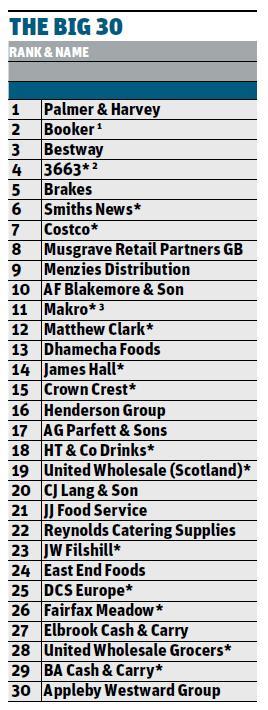
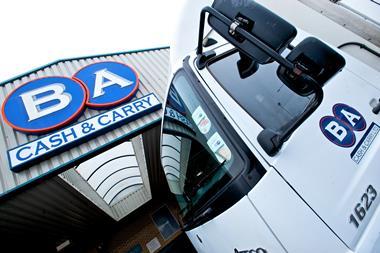
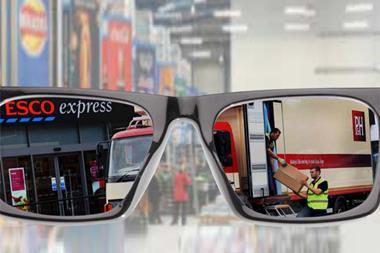
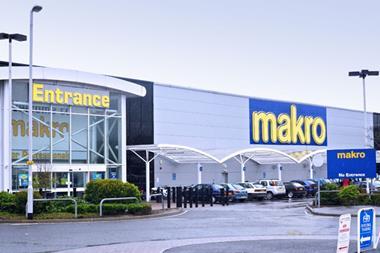



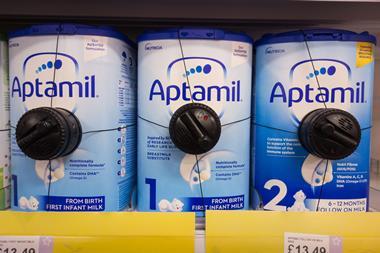
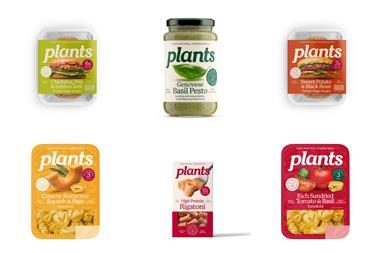




No comments yet